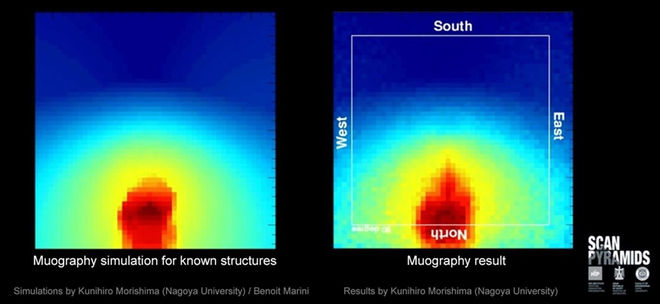It's long been suspected that the Great Pyramid of Giza contains vast, hidden networks of passageways and chambers that have managed to elude archaeologists and looters alike for thousands of years.
And now researchers say they've found evidence of a strange void behind the pyramid's north face, and an unknown cavity high up in its northeastern edge - structures that are completely separate from the main channels and tombs inside the colossal monument.
The Great Pyramid of Giza - also known as the Khufu Pyramid - was constructed for Pharaoh Khufu more than 4,500 years ago, and at 146 metres tall (481 feet) when it was first erected, it's the largest such structure in the entire country.
A project called Scan Pyramids, which includes researchers from several universities, institutions, and technology companies from around the world, has been investigating the Great Pyramid to see what they can find when they scan its insides using a variety of non-invasive techniques.
Under the guidance of Egypt's Cairo University and the Paris-based organisation Heritage, Innovation and Preservation (HIP Institute), the researchers have used a combination of infrared thermography, 3D simulation, and muon radiography imaging to reveal certain anomalies in the structure.
In other words, they say they've found 'holes' where solid walls should be.
While infrared thermography is used to detect temperature variations inside a building or structure, muon radiography imaging works kind of like an X-ray - beaming particles called muons inside to bounce around the environment and provide a blueprint for a three-dimensional reconstruction.
"Just like X-rays pass through our bodies allowing us to visualise our skeleton, these elementary particles, weighing around 200 times more than electrons, can very easily pass through any structure, even large and thick rocks, such as mountains," one of the Scan Pyramids team, Mehdi Tayoubi, told Discovery News earlier this year.
Using these techniques to map the insides of the Great Pyramid, the researchers say they've detected an unknown cavity about 105 metres (345 feet) above the ground on the northeastern edge of the structure, and some kind of "cavity" in the entrance gate behind the northern face.
There's no evidence of the two being linked in any way.
"Having conducted those three complementary techniques, we are now able to confirm the existence of a 'void' hidden behind the North Face, that could have the form of at least one corridor going inside the Great Pyramid," they announced in a press release this week.
"The precise shape, size, and exact position of this void is now under further investigation. It should be done with the help of 12 new muon emulsion plates that are installed in the descending corridor, and will be collected by the end of October 2016."
The team says several studies have been conducted to show that an excess of muons - which could indicate a void - was not statistical fluctuation or noise.
"The comparison with detailed simulations shows that this excess is largely above 5 sigmas. A 5 sigma excess corresponds to an effect with a probability above 99.9999 percent," they explain.
 Credit: K. Morishima, Benoit Marini, Scan Pyramids
Credit: K. Morishima, Benoit Marini, Scan Pyramids
The Scan Pyramid researchers say their case for the existence of undiscovered cavities is made stronger by the fact that a clear thermal anomaly was detected in November 2015 behind the northern face of the pyramid, right where four visible chevrons - blocks placed in an inverted V shape - overhang a descending corridor.
"We have also to keep in mind that inside the Great Pyramid there are other chevrons covering the King and the Queen Chambers," they say.
"In ancient architecture, chevrons were not used for decoration, but they have had a very practical purpose: to protect a void and prevents the roof from collapsing. The question posed here was: why so many chevrons are put to protect such a small area at the beginning of the descending corridor?"
Of course, this is all speculation for now, because while they have evidence that something strange is going on in these two parts of the pyramid, until we actually see a physical chamber, void, or passage with our own eyes, nothing can be confirmed.
And researchers outside the project aren't exactly convinced.
As Owen Jarus reports for Live Science, an oversight team led by former Egyptian antiquities minister, Zahi Hawass, issued a statement through the Egyptian Ministry of Antiquities in which they deliberately avoided using the words "voids" or "cavities" to describe the find.
They also recommended that the Scan Pyramids project be extended by another year so more data can be gathered on the newly found "anomalies".
Hawass went on to tell Seeker that his hunch as an archaeologist is that the anomalies are simply the result of construction.
"These people are scientists and do not have an archaeological background," he said. "The core of the pyramid was built using long stones and small stones. If you know that, you'll find anomalies everywhere."
"I think there are no secret rooms and these anomalies have to do with the way the pyramid was built," he added.
Only time will tell whose hypothesis is right, but whatever happens, it's pretty exciting to be along for the ride.
